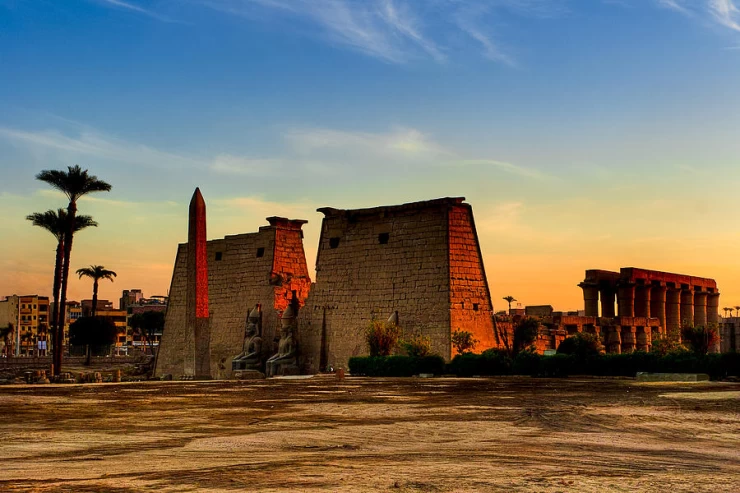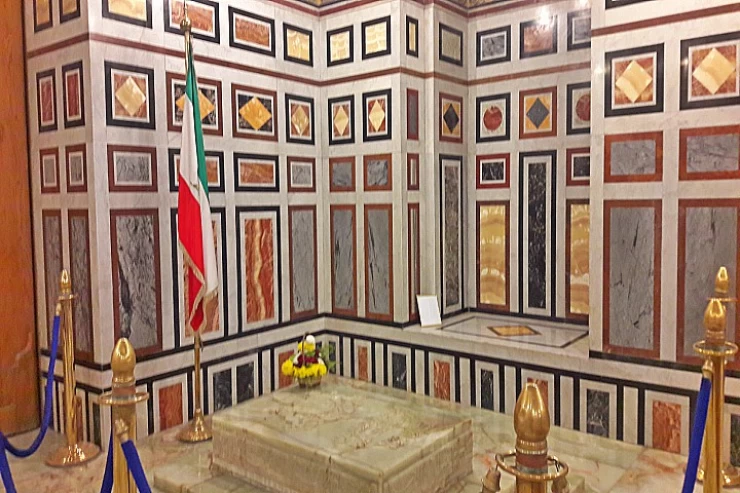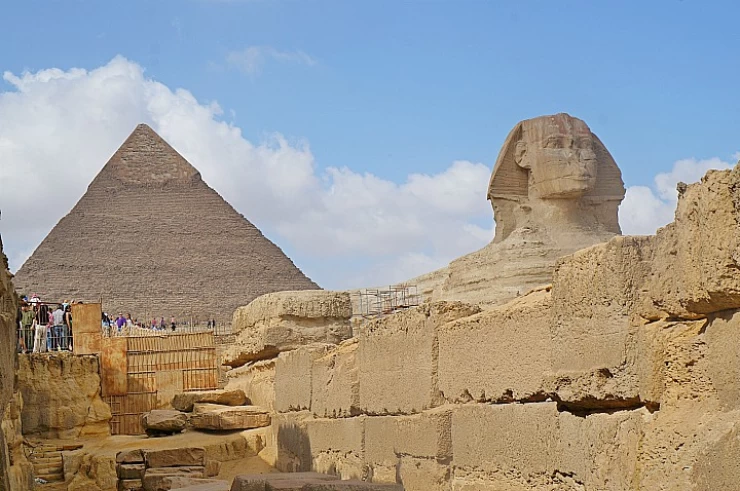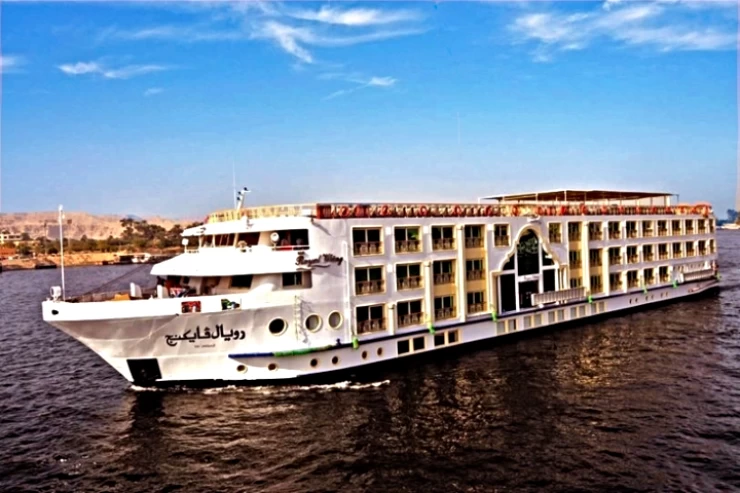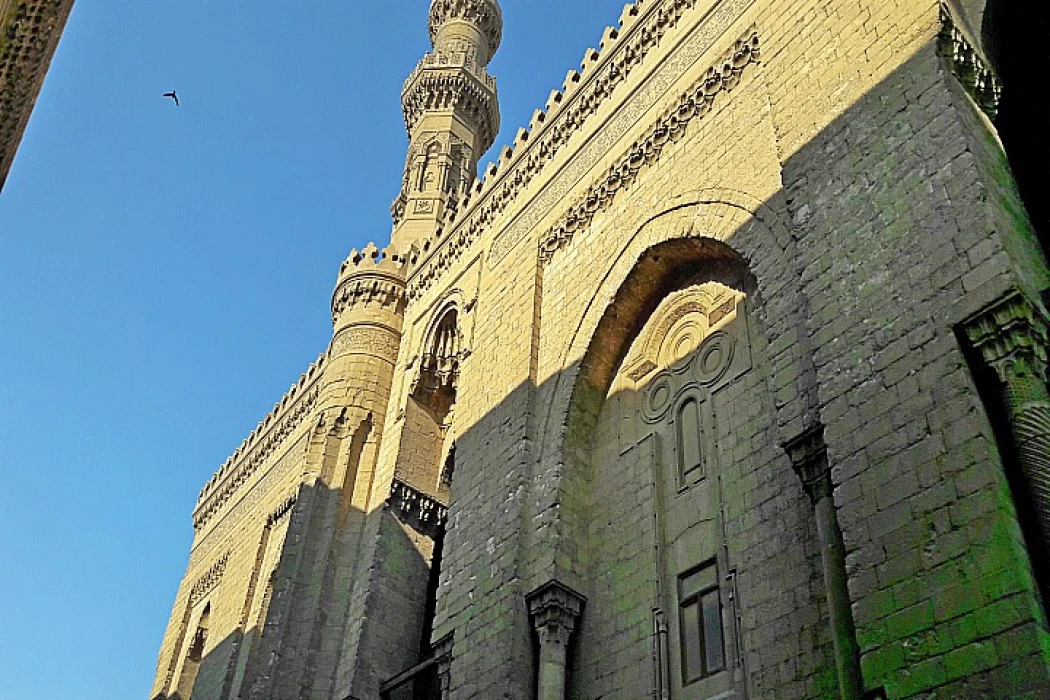
Al Rifai Mosque
Cairo's Al Rifa'i Mosque
Islamic architectural style that these mosques were built in makes them almost homogenous and this has also made them feature in many movies. Nowadays they are tourist attractions with high wall ace windows reflecting light creating a sparkling sight when viewed from afar.
The Rifa'i Mosque is situated beside Sultan Salah al-Din al-Ayoubi Citadel which is located in Khalifa City to the south of Cairo, and the latter has cast the history of its construction and origin of its name, after Imam Ahmed al-Rifai who was born in Al-Hejaz, then went to Iraq and then settled down in Egypt; thus all those who are lucky enough to visit this mosque get amazed by the magnificent decorations on its engravings on the outer walls and huge columns at its main entrance.
The question of why Khushiyar Hanim, the mother of Khedive Ismail, chose this corner and its buildings in 1869 called Zawya al-Rifai near Salah al-Din Square in the Citadel as the resting place for some members of Muhammad Ali family including grandson King Farouk, who happened to also be Egypt’s last king and son of King Fouad who was Khedive Ismail’s son, remains a mystery to everyone.
The construction came to a halt when Khushiyar Hanim died in 1885 but resumed after a period of twenty-five years upon an order from Khedive Abbas Helmi II when it was opened for prayer on the first day of Muharram in 1330 AH /1912 AD.
The mosque has the tombs of Sheikhs Ali Abu Shabak and Yahya Al-Ansari, as well as the tombs of the royal family, where Khedive Ismail, his mother Khushiyar Hanim, interred there are King Fuad I, King Farouk I, Sultan Hussein Kamel and his wife, and the mosque's founder.
The site of the mosque was formerly “Zawiya al-Rifai”, in which Sheikh Ali Abi Shabak al-Rifai is buried, and his tomb is still in the mosque, from which the mosque took its name. The mosque is currently located in Salah al-Din Square in the Khalifa neighborhood of Cairo's Southern District.
In the opinion of an artist, this is simply decoration to divide up the geometric spaces, but it’s a fact that they happened to be present. For instance, large crosses formed on facades of high-rise mosque can only be architecturally modeled after Gothic windows while ideating their shapes architecturally, however from structural perspective they point to load-bearing principles particularly considering the exceptional height of its outer walls.
Moreover, the Gothic windows – which by their nature relate to load distribution theory – especially bear on these particularly large external wall heights showing how Egyptian tastes had accepted them. Their importance in Islamic architecture has long been known since there are finding such figures at times ‘crowned’ columns as depicted at Nasser Muhammad’s Mosque situated within Citadel surrounded by ancient building materials reflecting on its composition.
It was inbuilt in 2 totally different periods, that is between 1869 and 1912, thus it's characterized by totally different inventive and subject designs. Next to that stands the far better well-known ruler Sultan Hassan Mosque, chemical analysis back to the ordinal century, that has remained intact despite the troubled centuries of history.

The prodigious size of the house of worship is most hanging. it's counted jointly of the main things to do in Cairo and is located in Midan El Qala’a, right below the Citadel of Salah El -Din in the foremost central part of Islamic Cairo. you'll be able to reach the house of worship of Al Rifa’i through a mutual entrance shared by the 2 mosques this one and therefore the mosque of Sultan Hassan.

Many renowned folks are buried here in Al Rifai house of worship, tons of them belong to soldier family-like Kushyar Hanim ordered its construction in 1869, and her son the renowned Khedive Ismail, United Nations agency refurbished Cairo and most of Egypt likewise as Sudan that wont to be a part of the Egyptian kingdom. The house of worship hosted the deceased body of Muhammad Reza Pahlavi crowned head Pahlavi, known for being the ultimate of Iran before the Moslem Revolution, that caused the Ruholla Khomeini rule.
within the same burial space lies the Shah’s son, Mohamed Reza Pahlavi died in 1980 whereas in exile in Cairo. Another notable figure buried here was Yehya Al Ansari, a guide of the Prophet Mohamed ( peace be upon him) and native saint Ali Abu-Shubbak. though not technically buried within the house of worship Arab chief Ali Al Rifai, the United Nations agency was a number one figure in Islamic Cairo throughout medieval times, including a shrine wherever several locals return till at the present time to hope and receive a number of his blessings.
Before the large reconstruction, Al Rifai house of worship was situated at the positioning of a little house of worship named Rifai Zawiya and was believed to create several of the known scholar followers and students, you'll be able to visit the house of worship throughout any of the regular Cairo Day Tours
Perhaps you may value more highly walking to the house of worship from the castle of salaah El-Din Street, and there's a motivating read of the traditional Egyptian homes awaiting appreciation. you'll be able to conjointly get near to the house of worship via Sayeda Aisha Street, which is able to conjointly lead you to the most gate. it's a double gate shared by each Al-Rifai and ruler Hassan, you may pass it through the protection scanner or detector. the 2 mosques are separated by a comparatively slender pedestrian street, and therefore the huge structure of the Al-Rifai house of worship mustn't be stunning if its size and talent to contend with the neighboring ruler Hassan house of worship, had been of utmost importance.
When you walk shortly towards the entrance of the Al Rifai house of worship, a high step takes you to a large portal. As a sort of respect and to avoid confusion, guests to the house of worship should be able to take away their shoes before they enter, and therefore the girls are kindly requested to wear incommunicative garments and that they will bring on a headband.
The house of worship includes a nice similarity to several of the fashionable structures. Once within, one will solely notice the attractive ceiling. Gold was especially foreign from Turkey for coating. guests ought to be happy to wander around within this subject marvel. we advise you to visit the burial places of Khedive Ismail and Reza crowned head Pahlavi.
Once you're finished viewing of these Islamic patterns, be happy to run your hands across the shrine of Al Rifai marked by inexperienced lights within the space right within the middle of the house of worship. you'll be able to even scan your prayers or create a would like that may be certainly fulfilled! If you're visiting the mosque on a Friday morning it'll be most of the time quiet and empty.







